07.04.2005
S. Ionov. Portrait of a chess player – Alexey SHIROV
A first time I paid attention to Alexey Shirov's creative play was when I saw his games against experienced Latvian master.
A. Shirov – V. Zhuravlev A80
Riga, 1986
1.d4 d5 2.¤c3 f5 3.g4. The choice of the text move shows that Alexey strives for open positions, which are most suitable for his imaginative style.
3...fg4. More safe is 3...¤f6 4.g5 ¤e4, but, of course, the capture is not a mistake either. Zhuravlev probably decided to accept the challenge and to play in a spirit of old masters, who considered accepting such sacrifices as a matter of honor.
4.Ґf4 ¤f6 5.h3 c6 6.Јd3 ¤a6 7.0–0–0 Јa5 8.Јe3 b5! Black develops dangerous Q-side initiative.
9.h:g4 b4 10.¤b1 Ј:a2 11.Ґh3. Most players would prefer 11.f3, restricting the opponent's choice of active continuations, but this would impede White's K-side development.
11...b3!
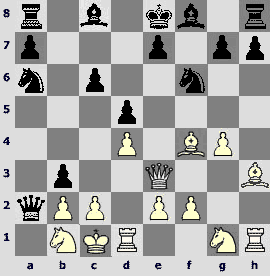
12.c3. White decides to cast prudence to the winds. 12.Јb3 Јb3 13.cb3 ¤g4 with minimal chances for survival wasn't something our 14-year-old hero could accept.
12...¤:g4 13.Јg3?! "We sing a song to the madness of the brave!" The situation rapidly becomes critical. 13.Ґg4 Ґg4 14.Јe5 looked more acceptable, as White, despite being two pawns down, could nevertheless hope for satisfactory result in view of Black's K-side underdevelopment
13...Ґf5 14.¦d3 h5 (14...Ґd3 15.ed3 ¤f6, and Black's material advantage should tell) 15.f3 h4. Deserved attention also 15...g5! 16.Ґg5 ¦g8, and black rook has things to do on g-file, while dark-squared bishop could create threats on c1-h6 diagonal.
16.Јg2 Ґ:d3. Here 16...g5 would be less desirable in view of 17.e4! gf4 18.Ґg4.
17.e:d3 ¤f6 18.Ґe6
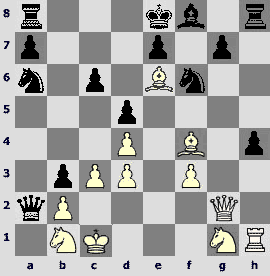
A picturesque position. Black pieces are stamped to the 8th rank.
18...ўd8, aiming against bishop on e6. I think it was advisable to be less materialistic and play 18...g5 19.Јg5 ¤c7! (20.Ґc7? Ґh6), and Black's position is close to winning.
19.¤h3 ¤c7 20.¤g5 ¤:e6 21.¤:e6+ ўc8 22.Јh3 ўb7 23.¤c5+ ўb6 24.¤d7+ ¤:d7 25.Ј:d7.
After the forced play one gets an impression that White's initiative is sufficient to make at least a draw.
25...e5 26.Ґ:e5 Јa4 27.c4! Brining the reinforcements to the attack!
27...Ґb4. 27...dc4 could lead to a draw after 28.¤c3 Јa1 29.ўd2! Јb2 30.ўe3 Јc3 31.Јc7 ўb5 [плохо 31...ўa6?? 32.Јc6 ўa5 33.Ґc7 ўb4 34.Јb7 ўa3 35.Јa6 ўb2 (35...ўb4 36.Јa5#) 36.Јa1 ўc2 37.Јb1(c1)#!] 32.Јb7 ўa4 33.Јc6 ўb4 with perpetual.
28.¦g1
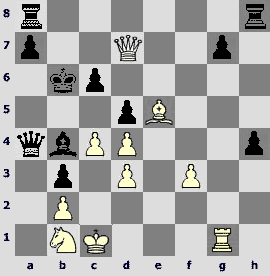
28...¦ag8? Zhuravlev cracks under pressure. One has to admit that his task wasn't easy. The following line illustrates Black's difficulties: 28...dc4 29.¦g6 ¦h6 30.¦g7 Јa6 31.Ґc7 ўb5 32.¦g5 ўa4 33.¤c3 Ґc3 34.bc3 b2 35.ўb2 Јb7 36.ўa1 a5 37.¦g2 with a big advantage 28...g5 deserved attention. After the text Shirov elegantly concludes the attack.
29.Ґc7+ ўa6 30.¦g6 ¦h6
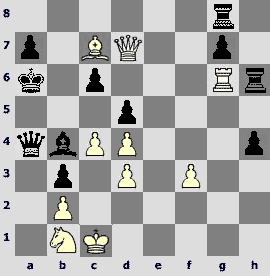
31.Ґb8!! ¦:b8 32.¦:g7 1–0
Already in this game one could see the potential of a big player aiming for sharp combinational play, his gift for maintaining a tension, precise calculation and little respect for authorities. Also, Shirov started his own opening research in very early age, which could be seen from the following game against future world championship candidate.
A.Shirov – G. Kamsky D44
Kapsukas, 1987
1.d4 d5 2.c4 c6 3.¤f3 ¤f6 4.¤c3 e6 5.Ґg5 d:c4 6.e4 b5 7.e5 h6 8.Ґh4 g5 9.¤:g5 h:g5 10.Ґ:g5 ¤bd7 11.e:f6 Ґb7 12.g3 c5 13.d5 Ґh6 14.Ґ:h6 ¦:h6 15.Јd2 Ј:f6. This sub-variation of the Botvinnik Slav was popular in 90th, and this was one of the first games on a subject.
16.¤e4. Also playable is 16. 0–0–0.
16...Јf3 17.¤d6+ ўe7 18.¤:b7

18...Ј:h1? Kamsky misses a stronger 18...¦h5! 19.d6! [worse is immediate 19.¦g1 ¦d5 20.Ґg2 ¦d2 21.Ґf3 ¦b2 22.0–0–0 ¦a2 23.ўb1 ¦a3 (23...¦f2? 24.¦d7 ўd7 25.¤c5 ўd6 26.¤e4) 24.¦d7 ўd7 25.¤c5 ўd6 26.Ґa8 ўc5 – the army of black Q-side pawns and the activity of remaining pieces compensates for material deficit (Zontakh – V.Popov, 2001)] 19...ўe8 20.¦g1 c3!? (after 20...¦e5 21.Ґe2 Јb7 White's advantage would be larger) 21.bc3 ¦e5 22.Ґe2 ¦e2 23.Јe2 Јc3 24.ўf1 Јa1 25.ўg2 Јe5 (25...Јd4?! 26.¦d1 Јa4 Ionov – V.Popov, St. Petersburg 1995, gives White a serious edge after 27. Јh5!) 26.Јe5 ¤e5 26.¦b1!, and White is better (C. Hansen – M. Mueller, Germany 2002).
19.d6+ ўe8 20.Ј:h6 Ј:b7? (more stubborn is 20...Јe4) 21.0–0–0. Stronger is 21.Јh4 ¤f8 22. Ґg2! winning on a spot, but after the text Black doesn't have much of a chance.
21...¤f8 22.Јf6 ¦c8 (22...¦d8 23.Ґg2 Јd7 24.Ґc6!) 23.h4 Јd7 24.Ґg2 Јd8 25.Јg7. 25.Јh8 would allow Black to extend hopeless resistance with 25...ўd7.
25...Јb6 26.Јg8 ¦d8 27.d7+. Black resigns, because he loses a knight. 1–0
The Botvinnik Variation attracted Alexey's attention throughout his career. More often he played it as Black, as with success. It is impossible to play such highly unbalanced opening based on common sense, and this tells a lot about Shirov's opening preferences. However, I would also like to add that Shirov conducts his opening research in popular systems (or sometimes he makes them popular).
R. Ponomariov – A. Shirov D44
Wijk aan Zee 2003
1.d4 d5 2.c4 c6 3.¤f3 ¤f6 4.¤c3 e6 5.Ґg5 d:c4 6.e4 b5 7.e5 h6 8.Ґh4 g5 9.¤:g5 h:g5 10.Ґ:g5 ¤bd7 11.g3 Ґb7 12.Ґg2 Јb6 13.e:f6 0–0–0 14.0–0 c5 15.d5 b4 16.¤a4 Јb5. Another line - 16...Јa6 17.a3 Ґd5 18Ґd5 ¤e5! became very popular after the game Ivanchuk – Shirov, Novgorod 1994.
17.a3 e:d5. Previously preferred 17...¤b8 18.ab4 cb4 lost its attraction because of19.Јd4! that was played for the first time in the game Shirov – Oll, Tilburg 1992. To 19...¤с6 White has very promising queen sacrifice 20.dc6! ¦d4 21.cb7 ўc7 22.Ґe3 with a strong initiative (Salov – Illescas, Madrid 1993, Kamsky – Kramnik, New-York 1994).
18.a:b4 c:b4 (18...d4!? is also interesting) 19.Ґe3 ¤c5 20.Јg4+ ¦d7 (20...ўb8 21.Јd4!) 21.Јg7!? or ?!.
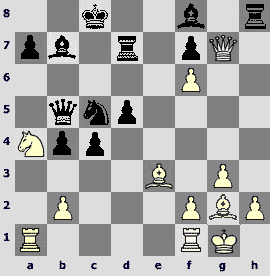
For the first time this stunning thrust appeared in the game Ivanchuk – Shirov, Wijk aan Zee 1996.
21...Ґ:g7 22.f:g7 ¦g8 23.¤:c5 ¦:g7. In the aforementioned game after 23...d4?! 24.Ґb7 ¦b7 25.¤b7 Јb6 26.Ґd4!! Јd4 27.¦fd1 White has scored a brilliant victory.
24.¤:d7?! Ponomarev has decided to continue the struggle. More cautious 24.Ґh3 f5 25.Ґf5 ¦gf7 26. Ґh3 ¦h7 with a pursuit of the bishop most likely leading to a draw.
24...Ј:d7 25.¦:a7 ¦g6 26.¦fa1
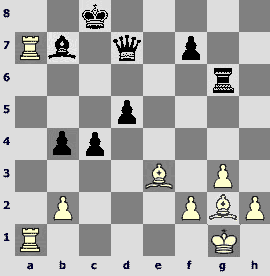
Preliminary activation of the queen 26...Јf5 was noteworthy with an exemplary variation 27.h4 ¦e6 28.ўh2 Јd3, and no serious compensation for the queen can be seen.
27.Ґd4?! allows activating the rook, and 27.¦a8 ўc7 28.¦8a7 comes across 28...¦e3! 29.fe3 Јe6 with a considerable advantage.
27...¦e2 28.h4 ¦d2 29.Ґe3 ¦:b2 30.¦1a5 b3. It becomes clear that it's impossible to hold black pawns.
31.¦c5+ ўd8 32.¦:b7 Ј:b7 33.¦:d5+ Ј:d5 34.Ґ:d5 ¦b1+ 35.ўg2 b2

36.Ґe4 (36.Ґc4 ¦d1! 37.Ґa2 ¦a1 with a win) 36...¦d1 37.Ґg5+ ўe8 38.Ґf6 b1Ј 39.Ґ:b1 ¦:b1 40.h5 ўf8 41.g4 (41.ўf3 c3) 41...¦d1 42.Ґb2 ўg8 0–1
The 4.f3 variation in Nimzovich Defense that leads to different knotty situations on board served him faithfully for a long time.
А.Shirov – V. Eingorn E20
Stockholm 1990
1.d4 e6 2.c4 Ґb4+ 3.¤c3 ¤f6 4.f3 d5 5.a3 Ґe7. More common continuation is 5...Ґc3 6.bc3 c5. When Alexei's favorite line 7.cd5 ¤d5 8.Јd3 became less fruitful he excluded it from his repertoire.
6.e4 c5. Shirov produced very good results after 6...de4 7.fe4 e5 8.d5.
7.c:d5 e:d5 8.d:c5 Ґ:c5. Another possibility is 8...d4 9.¤a4 0–0 10.b4. Black's initiative does not fully compensate the sacrificed pawn.
9.e5 ¤fd7. 9...Је7? does not work as10.Јe2 ¤h5 11.¤d5 Јh4 12.g3 ¤g3 13.hg3 Јh1 14.Ґe3! leads to the decisive advantage.
10.Ј:d5 0–0
10...Ґg1 11.¦g1 Јb6 12.Јd6!; 10...Јb6 11.¤e4!; 10...¤c6 11.f4 Јb6 12.¤f3 Ґf2 13.ўe2 ¤c5 14.b4! – White has advantage in all cases.
11.f4 Јb6
11...Ґg1 12.¦g1 Јb6 (12...Јh4? 13.g3 Јh2 14.Јg2±) 13.¦h1 ¤c6 (13...¤c5?! 14.b4) 14. Јb5 ¤d4 15.Јb6¤b6 16.Ґd3 ¦d8 17.Ґe3±.
12.¤f3 Ґf2+ 13.ўe2 ¤c5!?
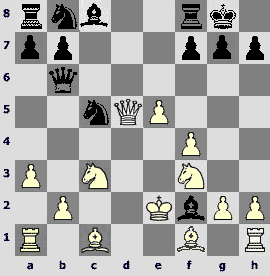
14.b4. If this move had not been made, it would have been possible to sacrifice the queen: 14.ўf2 ¦d8! 15.Јd8! Јd8 16.Ґe3 with a good compensation. Intermediate 16.¦b1 Јa5 17.¦b5 Јb5 18.¤b5 ¦d5 19.¤c7 looks stronger. 16.Јa2 gave a good chance to repulse an attack with an exemplary line 16...¤c6 17.¦b1 Јa5 18.Ґd2 Ґg4 19.ўe1Ґf3 20.gf3 ¤d4 21.Ґe2 ¤e2 22.¦b7! and wins. But it seems that Alexei didn't want to move his knight from the center as he was fascinated with a position in the game.
16...Јb3! 17.Ґd2™ ¦:d2+ 18.ў:d2 Јb2+ 19.ўd3 Ј:a1
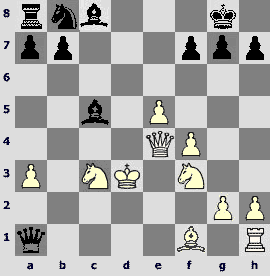
20.e6! Tempting 20.¤g5 did not work: 20...¤c6! (20...g6? 21.Јd5!Ґf5 22.ўc4) 21.Јh7 ўf8 22. Јh8ўe7 23.¤ge4 (23.¤d5 ўd7 24.Јh3 ўe8 25.Јh8=) 23...Јa3 24.Јg7 Ґe6 25.Јf6 ўe8 26.Јh8 ўe7 27.Јf6=.
20...f:e6
20...Ґe6 21.¤g5 [21.Јb7 Ґf5 22.ўd2 Ґe3 (22...Ґd7!? with the idea 23.Јa8? Јb2 24.ўd3 Ґc6) 23.ўe3 Јc3 24.Ґd3! (24.ўf2=) 24...Јd3 25.ўf2 Јc2 26. ўg3 Ґe4 (26...Јc6 27.¦d1! Ґd7 28.Јc6 ¤c6 29.¦d7 І/±) 27.¦e1! ¤d7 (27...f5? 28.¦e4!) 28. Јe4 Јe4 29.¦e4І] 21...Ґb3!? [21...Јa3 22.Јh7 ўf8 23.Јh8 ўe7 24.¤e6 Ґb4 (24...Јa6? 25.ўc2 Јe6 26.Ґb5! with attack) 25.ўe4!! ¤d7! (25...Јc3?? 26.Јd8 ўe6 27.f5 мат!) 26.Јa8 Јc3 27.Јb7 ўe6 28.Јd5 ўe7 29.Јc4 ¤ c5 with a compensation] 22.Јh7 (22.Јb7? Јb2) 22...ўf8 23.Јh8 ўe7 24.Јg7 Јe1 led to a position which is difficult to evaluate, especially during the tournament game.
21.¤g5 g6 22.Јe5 Ґe7 23.¤:e6
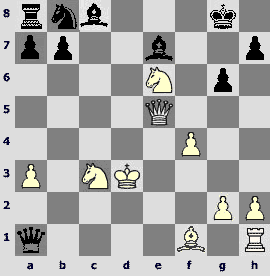
23...ўf7?
23...Ґf8! 24.¤f8 ¤c6 25.Јf6 Ґf5! [25...Јa3 26.ўd2! (26.¤g6 Ґf5! 27.Јf5 ¦d8 28.ўe3 Јc3 29.Ґd3 Јd4 30.ўe2 Јb2=) 26...Јb2 27.ўe1 Јc1 28.ўe2! (28.ўf2 Јd2 29.¤e2 Јd8!=), there is no satisfactory response for Black] 26.ўe3 ¦e8 27.ўf3 ¤e5! 28. Јe5 ¦e5 29.Ґc4 ўf8 30.¦a1 ¦c5=.
24.Јg7+! ўe8 (24...ўe6 25.ўc2! Јa3 26.Ґb5! ¤c6 27.Ґc4 ўd7 28.¦d1Јd6 29.¦d6 ўd6 30.¤e4 ўc7 31.Ґb5 with a win) 25.¤c7+ ўd8 26.Јh8+ ўd7 27.¤:a8 Ј:a3 28.ўc2 1–0
Shirov reconstructed his opening repertoire in the first half of 90s, when he had already been playing permanently in super tournaments. 1. e4 became his most common first move. Of course 1.e4 openings are more in keeping with his creative individuality and despite the first failures he succeeded to extend his potential. In the variation played in two following games, White sacrifices a knight for a not very obvious compensation straight away. Alexei is an apologist of this line for White.
А.Shirov – B. Gelfand B81
Wijk aan Zee 1996
1.e4 c5 2.¤f3 d6 3.d4 c:d4 4.¤:d4 ¤f6 5.¤c3 a6 6.Ґe3 e6 7.g4. "Cautious" 7.f3 is more popular now.
7...e5. The most principled response. White has to sacrifice one or even two minor pieces.
8.¤f5 g6 9.g5 g:f5 10.e:f5 (after 10.gf6 f4 White is at a deadlock) 10...d5! 11.g:f6. Another possibility 11.Јf3 was shown in the next game.
11...d4 12.Ґc4 Ј:f6?! In the heated skirmish 12...Јc7!? 13.Јd3 de3 14.0–0–0 ef2 15.Ґf7! ўf7 16. Јd5 etc. the attack and defense seem to be balanced.
13.¤d5 Јc6
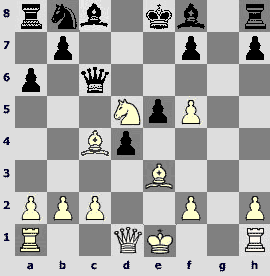
14.Ґ:d4! Ґb4+! 15.c3 Ј:c4 16.Ґe3 Ґa5 17.¤f6+ ўe7 18.¤d5+ ўe8 19.¤f6+ ўe7 20.Ґg5! Ґc7
20...Јc6 21.Јb3!! Јh1 22.ўe2 Јa1 23.Јa3 ўd8 24.¤e4 with a checkmate; 20...¦d8!? 21.¤h7 (21.Јb3 Јb3 22.ab3 ¤c6 23.b4 Ґc7 24.b5) 21...f6 [21...ўe8 22.¤f6 ўe7 23.¤e4 ўf8 (23...ўe8? 24.Јd8! Ґd8 25.¤d6 with a win) 24.Јg4 ¦d4 25.f3±] 22.Ґf6 ўe8 23.Јh5 Јf7 24. Јh6 with serious complications.
21.¤e4+
21. Јd5! Јd5 22.¤d5 ўd6 23.0–0–0 ўc6? 24.¤e7 ўb6 25.Ґe3 ўa5 26.¦d5 b5 27.a4!, and a mating attack can not be avoided (given by Shirov); more stubborn is 23...Ґf5 24.¤b6 ўe6 (24...ўc6 25.¤a8 Ґd6 26.¤b6Ґe6 27.c4±) 25.¤a8 Ґa5 26.Ґe3 (26.b4 ¤c6) 26...¤d7 27.b4 ¦a8 28.ba5 ¦c8 with a chance to rescue.
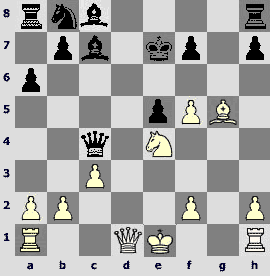
21...ўe8? Stronger was 21 ...ўf8! 22.Ґh6 ўe8! (22...ўe7 23.Јg4 ¤d7 24.0–0–0! With a strong attack, for instance 24...Јa2 25.Јg5 ўe8 26.Јg7 Јa1 27.ўd2 Јb2 28.ўe1 ¦f8 29.¤f6 ўe7 30.Ґg5 Јc3 31.ўf1 Јc4 32.ўg1,and no more checks). Now if White is not willing to risk much (for instance, 23.Јg4 Јc6, attacking the bishop), he could content himself with a perpetual check: 23.¤f6 ўe7 24.¤d5 ўe8=.
22.Јg4 b5 23.¤f6+
23.0–0–0 h5 (23...¤d7 24.Ґh6! Јa2 25.Јg7) 24.Јh4 Јa2 25.¤f6 ўf8 26.¦hg1!, and it's difficult for Black to defend against the threats to his king.
23...ўe7 (23...ўf8? 24.Ґh6 ўe7 25.Јg5) 24.0–0–0. The consequences of 24.Јg2 are difficult to evaluate, and both players were also short of time. Shirov makes a practical decision: White keeps initiative in the ending.
24...Ј:g4 25.¤:g4+ ўf8™ 26.Ґh6+ ўe7 27.Ґg5+ ўf8 28.Ґd8! Ґ:f5 29.Ґ:c7 ¤c6. 29...Ґg4 30.¦d8 ўg7 31.Ґe5 f6 32.Ґf6 ўf6 33.¦h8 loses; more stubborn is 29...¤d7 with chances for a draw in the ending without a pawn. Now the knight changes his itinerary.
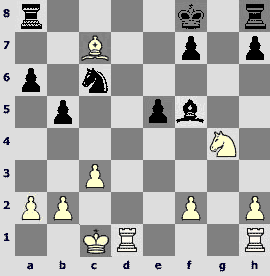
30.¤h6!? Ґg6 (30...Ґe6 31.¦hg1 – the initiative along the open files is very intensive) 31.¦d6 ¤b4! 32.c:b4 ўg7 33.h4 ¦hc8. It would have been better to put another rook on c8 - 33...¦ac8 34.¦c6 (34.h5 ¦c7 35.ўd2 ¦c2 36.ўe3 ўh6) f6 with good chances for a draw.
34.h5 ¦:c7+ 35.ўd2 Ґe4. 35...f5 was noteworthy, trying to arrest the knight on the edge of the board.
36.¦g1+ ўh8 37.ўe3
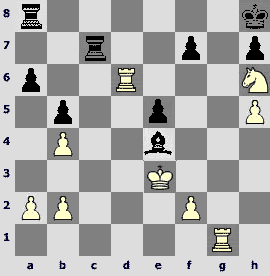
White domination is impressive in the position with even material.
37...Ґb7 38.¦gd1 ¦e8?! Black who is in time-trouble takes a soft option. More stubborn is 38...¦f8 39.¤f5 ¦c4 40.f3±, meaning a beautiful variant 40...¦f4? 41.¦d8 ¦f3 42.ўe2 ¦f5 43.h6!! with a mate (given by Shirov).
39.¤f5?! More simple is 39.¦d7 ¦d7 40.¦d7 with a decisive advantage.
39...Ґc8? After this mistake the struggle comes to an end.
40.¦d8 Ґ:f5 41.¦:e8+ ўg7 42.¦:e5 1–0
А.Shirov – V. Topalov B81
Wijk aan Zee 2001
1.e4 c5 2.¤f3 d6 3.d4 c:d4 4.¤:d4 ¤f6 5.¤c3 a6 6.Ґe3 e6 7.g4 e5 8.¤f5 g6 9.g5 g:f5 10.e:f5 d5 11.Јf3 d4 12.0–0–0 ¤bd7 13.Ґd2 Јc7 14.g:f6. Continuation 14.Ґd3 ¤c5 15.gf6 dc3 16.Ґc3 Јc6 17.Јe3 e4 did not provide White with a sufficient compensation in the game Shirov - Svidler, Poland 2000.
14...d:c3 15.Ґ:c3 Јc6
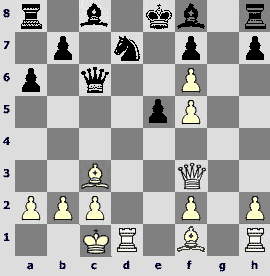
16.Јg3! Ґh6+. In the game Shirov – van Wely, Istambul 2000, Black decided to take the rook - 16...Јh1 17.Ґg2 Ґh6 18.Ґd2 Ґd2 19.ўd2, but right away he made a mistake and lost quickly: 19...Јg2?? 20.Јg2 a5 21.f4! ef4 22.Јg7 ¦f8 23.¦e1 ўd8 24.¦e7 ўc7? 25.Јf8 1:0. Of course, 19...Јd1 20.ўd1 was better. Development troubles of Black seem to compensate White's material deficit, for example 20...a5 21.Ґf1, hampering the activation of the rook and aiming at b5.
17.ўb1 Ґf4. The capture of the rook in this case leads to the position with strong initiative for White: 17...Јh1 18.Ґe5 Јe4 19.Ґc7 Ґd2 20.Ґd3.
18.Јd3 ¦g8. It's more reliable to move the king out of center - 18...0–0 19.¦g1 ўh8 20.Ґb4 ¤c5! (after 20...¦g8? 21.¦g8 ўg8 22.Ґe7 h6 23.Ґe2 White obtained an advantage (Shirov – van Wely, Poland 2000) 23...¤f6 24.¦g1 ўh7 25.Ґf3 e4 26.Јb3 Јd5 27.Ґf6 Јb3 28.¦g7 ўh8 29.ab3 ef3 30.¦g4± – given by Shirov) 21.Јh3 Јf6 22. Ґc5 Ґf5 23.Јa3 with unclear play (given by Shirov).
19.Ґh3 ўd8?
The wish of Black to move his king out of center is understandable, but it becomes impossible after the response of White. The immediate capture of the pawn looked more naturally - 19...Јf6, and although the position is still sharp, it's not easy for White to prove that their pressure is worthy of the sacrificed piece.
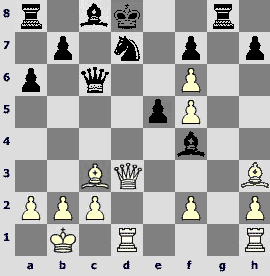
20.Ґb4! Ј:f6 21.Јc4 ¦g5? Loses immediately, although a good advice is of use to Black. 21...b5 22.Ґa5 ўe8 23.Јc7 b4 24.¦hg1; 21...a5 22.¦d6 Јh4 (22...Јg5 23.f6 ab4 24.¦hd1) 23.Јf7 ab4 24.¦hd1 ўc7 25.¦d7 ўb8 26.Јg8 Јh3 27.¦d8 Јf5 28.¦1d7 ўa7 29.¦c8; 21...ўe8 22. ¦he1 a5 (22...Јh4 23.f6 Јh3 24.Јc7 Јe6 25.¦d6) 23.Ґd6 Ґh2 24.f4. These lines are not exhaustive but they show the danger of Black's position. It seems that the root of the trouble is in the 19th move.
22.¦d6 Јg7 23.f6 ¦g1+ 24.Ґf1
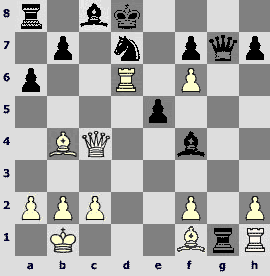
One mistake is enough in such a sharp position. The following final could have taken the place: 24...Јg2 25.Ґa5 b6 26.Ґb6 ўe8 27.¦e6! fe6 28.Јe6 ўf8 29.Ґc5! ¤c5 30.Јe7 ўg8 31.Јe8#, but Topalov conceded defeat at the proper time. 1-0
All the discussed above games are congenial to the Shirov's game collection «Fire on board». While the bright gift can make it possible to climb Olympus, one won't stay for a long time on the top not having different struggle armory. So, we'll have a look at the ending strategy of our hero.
V. Topalov – A. Shirov
Linares 1998
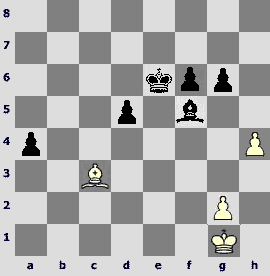
47...Ґh3!! The fire goes on at almost empty board – piece sacrifice for a few tempi.
48.g:h3. 48.ўf2 ўf5 49.ўf3 does not help, kamikaze-bishop sacrifices himself: 49...Ґg2! 50.ўg2 ўe4.
48...ўf5 49.ўf2 ўe4!
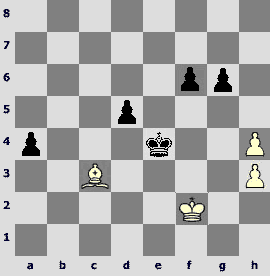
50.Ґ:f6. After 50.ўe2 f5 White can not hold three passed pawns of Black supported by the centralized king.
50...d4 51.Ґe7 ўd3 52.Ґc5 (avoiding ўc2 and d3) 52...ўc4, winning a decisive tempo.
53.Ґe7 ўb3 0–1. 54.ўe2 ўc2 55.Ґb4 d3 56.ўe1 a3, and one of the black pawns queens.
In the next game Aleksei suddenly confused his opponent.
A. Greenfeld – A. Shirov
Budapest 1996
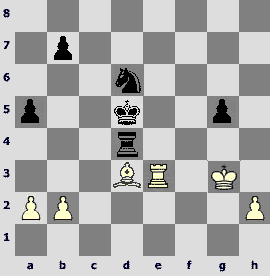
43...b5. Black strengthens as much as possible his forces on the Queen side but of course it is difficult to imagine any other result but a draw.
44.ўf2 ¦h4 45.h3 ўd4 46.¦g3 b4 47.ўe2 ¤f7 48.Ґf5 ¦h6 49.ўd1. A bit strange move that lets a black rook to the second rank.
49...¦f6 50.Ґh7 ¦f2 51.ўc1 ¦h2
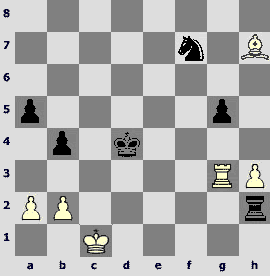
52.a3. Weakening of b3 had a fatal effect later. 52.¦g4 is easier, throwing back the king.
52...¤e5 53.a:b4 a:b4 54.Ґf5. White avoids losing the bishop after 54.¦g5 ¦h1 55.ўc2 b3! 56.ўb3 ¦h3 with a drawish position, but a crucial mistake is imminent. 54...¦f2 55.¦:g5? b3!
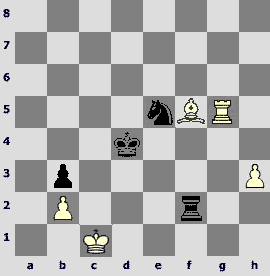
56.¦g3? Here it is. The bishop ought to have been taken away - 55.Ґg6 and there is no way to win both after 55...¦f1 56.ўd2 ¦f6 57.¦g3, and 55...¤f3 56.¦g4 ўc5 57.ўd1¦d2 58.ўc1 ¦e2 59.¦e4 ¦g2 60.¦g4.
56...¤f3! 57.¦g4+. The sacrifice of exchange did not save the situation. 57.¦f3 ¦f3 58Ґg4 ¦f1 59.Ґd1 ўd3 60.h4 ¦e1 61.h5 ¦h1 62.h6 ўc4 63.ўd2 ¦h6 64.Ґe2 ўd4 65.Ґd1 ¦h2 66.ўc1 ўc4 67.Ґg4 ўd3 68.Ґf5 ўe3 (given by Shirov).
57...ўc5! 58.ўd1
58.Ґd3 ¦h2 59. Ґf1 ¦h1 60.ўd1 ¦f1 61.ўe2 ¤h2 62.¦g3 ўb4 63.¦g2 ¦c1 (given by Shirov).
58...¦d2+ 59.ўc1 ¦h2 60.ўd1 ¦h1+ 61.ўe2 ¤d4+ 62.ўd3? Is more stubborn though it didn't redeem the position. 62.ўf2 ¤f5 63.¦g5 ¦h2 64.ўe1 ¦b2 65.¦f5 ўb4 66.ўd1 ¦c2! (given by Shirov).
62...¤:f5 63.¦g5 ¦:h3+ 0–1 (64.ўe4 ўc4 65.¦f5 ¦h2).
This is an example of making use of two weaknesses in the ending with bishops of the same colors.
G. Kamsky – A.Shirov
Buenos Aires 1994
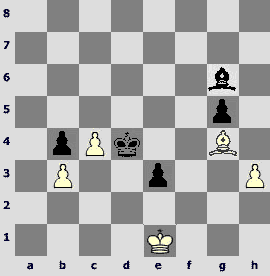
It's not difficult to notice the weaknesses – pawns b3 and h3, placed and fixed on the bishop color squares. Certainly things have been made more complicated by the passed pawn of the White.
55...Ґc2! Black wins the tempo for shifting the bishop on e4.
56.Ґd1 Ґe4 57.Ґg4 ўc3 58.ўe2. Black has a simple task in case of 58.Ґd1 Ґg2 59.ўe2 ўd4.
58...ў:b3 59.ў:e3 Ґg2! Is of use in the variant 60.ўd4 ўa3 61.ўe5 b3 62.Ґf5 b2 63.ўf6 Ґh3.
60.Ґe6 ўc3
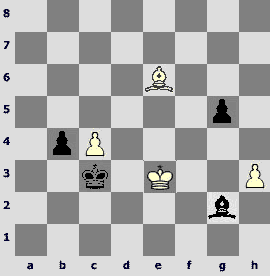
61.ўf2. After 61.c5 Ґc6! (61...b3? 62.Ґb3 ўb3 63.h4! gh4 64.ўf4 ўc4 65.c6=) a Zugzwang position arises. White has to let pawn "b" pass forward. 62.Ґg4 [62.Ґf7 Ґd7 (62...b3? 63.Ґb3 ўb3 64.ўf2 ўc4 65.ўg3 Ґd7 66.h4=)] 62...b3 63.Ґf5 b2 64.Ґb1 Ґd7 65.Ґe4 Ґh3 65.c6 Ґc8 66.c7 g4 67.Ґg6 ўb3 68.Ґb1 (68.Ґf7 ўc2) ўc4 69.ўd2 ўc5 70.Ґg6 (70.ўc3 g3) 70...ўd6 71.ўc2 ўc7 72.ўb2 g3 73.Ґe4 Ґb7, and the pawn queens (given by Shirov).
61...Ґc6 62.c5 ўd4 63.ўg3 ў:c5 64.ўg4 Ґd5 65.Ґf5 b3 66.ў:g5 ўd4 67.h4 Ґe4 68.Ґe6 b2 69.Ґa2 ўc3 70.ўf4 Ґh7 71.h5 ўb4 72.h6 ўa3 0–1
The next game which is very important in competitive respect was almost the decisive one in the match. Kramnik underestimated the problems of the ending with bishops of opposite colors.
A. Shirov – V. Kramnik C43
Kasorla 1998
1.e4 e5 2.¤f3 ¤f6 3.d4 ¤:e4 4.Ґd3 d5 5.¤:e5 ¤d7 6.¤:d7 Ґ:d7 7.0–0 Ґd6. The continuation 7...Јh4 8.c4 0–0–0 9.c5 leading to a sore struggle is less popular now among distinguished chess players.
8.c4. In this position Shirov has played 8.¤c3 time and again: 8...¤c3 9.bc3 0–0. (9...Јh4 is interesting with an attempt to avoid the weakening of black squares). 10.Јh5 f5 11.¦b1 b6 12.¦e1, this is the way another game of this match proceeded. It's extremely difficult for White to make use of his slight advantage failing the cavalry able to gain a foothold on e5.
8...c6 9.c:d5 c:d5 10.Јh5. 10.¤c3 ¤c3 11.bc3 0–0 12.Јh5 f5 (12...g6 13.Јd5 Јc7) also leads to the positions with a slight advantage of White.
10...0–0 11.Ј:d5 Ґc6 12.Јh5 g6 13.Јh3 ¤g5 14.Ґ:g5. Having come across the unexpectedness (mainly it was played13...Ґb4), Aleksei makes the position simpler, but the hopes for getting an advantage vanish. The main line is14.Јg4 ¤e6 15.Ґh6 ¦e8 16.¤c3 Ґf4 17.Ґf4 Јd4 18.Ґe4 or 16...¤d4 17.¦ad1, which also doesn't offer many prospects to White.
14...Ј:g5 15.¤c3 ¦fe8. Later it was found out that 15...¦ae8 16.¦ad1 is more precise (in case of 16.d5 Ґd5 17.f4 Јd8 as against the game Black had secure f7) ¦e7 17.d5 Ґd7 18.¤e4 ¦e4 19.Јd7 Јe7, and White has an extra pawn which is difficult to be utilized.

16.d5! Ґ:d5 17.f4 Јd8 18.¤:d5 Ґc5+ 19.ўh1 Ј:d5 20.¦ac1! Supporting his bishop moving to the shooting distance on a2-g8 diagonal. With the bishops of opposite colors the initiative is the most important thing!
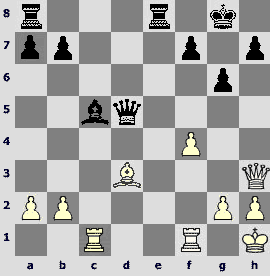
20...Ґe3. It was possible to play 20...¦e3 21.Ґc4 Јd4 22.Јh6 (22.Ґf7? ўg7 23.Јh4 Ґe7) 22...Ґf8 23.Јg5 Ґg7 24.f5 ¦e5, and Black has a good chance to stifle the initiative of White.
21.Ґc4. Tempting is 21.¦c3 Ґd4 [21...¦ad8 22.f5 Јe5 23.Ґc2 (23. Ґc4 gf5) Јb5 24.Јf3 with unpleasant pressure] 22. ¦c7 b5 [23...Јd8 24.¦d7 (24.¦f7!? ўf7 25.Јh7 ўe6 26.Јg6 ўd5›) 24...Јf6 25.Ґc4 ¦e7 26.f5! g5 27.¦e7 Јe7 28.f6 Ґf6 29.Јh6 ¦c8! 30.b3 ¦c6 31.Ґd3 with a minimal advantage] 23.¦d7 Јc5 24.f5 ¦e7 (24...¦e3? 25.Јh4! ¦d3 26.Јe4 with a double attack) 25.fg6 hg6 26.Ґb5 Ґb2 27.Јb3 Ґf6 28.Јf3 ¦b8, and black holds out.
21...Јf5 22.Ј:f5 g:f5 23.¦cd1. The ending is undoubtedly drawish but because of pawn f5 weakness requires precise defense from Black.
23...¦ad8 24.g3 Ґd4 25.b3 Ґf6 (25...ўg7= is easier)
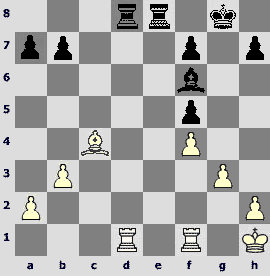
26.Ґb5! (avoiding the exchange of 4 rooks) 26...¦:d1 27.¦:d1 ¦d8 28.¦c1 ¦d5 29.a4 Ґd8 30.¦c8 ўg7 31.¦b8 Ґb6. A passive defense is possible 31...а6 32.Ґс4 ¦d7.
32.¦:b7 ¦d1+ 33.ўg2 ¦d2+ 34.ўh3 Ґg1 35.g4

35...Ґ:h2. Black has crashed under pressure and Shirov has got real winning chances. It was necessary to play 35...¦h2 36.ўg3 fg4 37.ўg4 ¦h6 38.Ґc4 ¦f6 39.f5 h5= (given by Kramnik).
36.g:f5 h5 37.ўh4 Ґ:f4 38.ў:h5 ўf6 39.Ґc4 ў:f5 40.¦:f7+ ўe4 41.¦:a7 Ґe5. As soon as the white king shifts to the queen side the game will be over. That's why Black tries to prevent this.
42.Ґf1 ¦f2 43.Ґh3 ¦f8 44.Ґe6 ¦f1? More stubborn is 44...¦f6 with a trap 45.¦e7? Ґd6 46.¦e8 ¦f8=.
45.¦d7 ¦h1+ 46.ўg6 ¦g1+ 47.ўf7 ¦g7+ 48.ўe8 ¦:d7 49.ў:d7
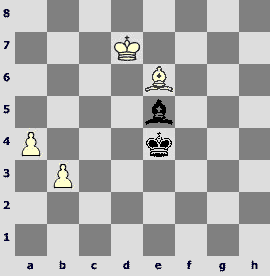
The exchange of rooks doesn't help much in this situation. White king managed to slip to the queen side while his opponent stands badly.
49...Ґc3 50.ўc6 ўe5 51.Ґg8 Ґe1 52.ўb6 Ґf2+ 53.ўa6 ўd6 54.a5 ўc7 55.b4 ўc6 56.b5+ ўc5 57.b6 ўb4 58.b7 Ґg3 59.ўb6 Ґf2+ 60.ўc6 Ґa7 61.a6 ўa5 62.Ґc4 Ґb8 63.Ґf1‡ 1–0
Bold play in the opening led to the ending, in which White's space advantage told.
A. Shirov – G. Kamsky D87
Linares 1993
1.d4 ¤f6 2.c4 g6 3.¤c3 d5 4.c:d5 ¤:d5 5.e4 ¤:c3 6.b:c3 Ґg7 7.Ґc4 c5 8.¤e2 ¤c6 9.Ґe3 0–0 10.¦c1. By this move White prevents the variant 10.0–0 Ґg4 11.f3 ¤a5 12.Ґd3 cd4 13.cd4 Ґe6, and to avoid the appearance of a black peace on c4, he has to sacrifice the exchange (14.d5) or the pawn (14.¦с1), losing his chance to castle. This move was invented by Polugayevsky.
10...c:d4 11.c:d4 Јa5+ 12.ўf1 Ґd7 13.h4 ¦fc8 14.h5 ¤d8
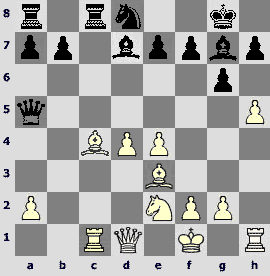
15.f4!? In their earlier encounter played in Moscow in 1992 it was played 15.f3 Ґa4! 16.Јd3 b5 17.Ґd5 ¦c1 18.Ґc1 ¦c8 19.hg6 hg6 20.Ґh6 Ґh6 21.¦h6 e6!, later on Kamsky repelled the reckless attack . If Black proceeds with playing in the same manner - 15...Ґa4 16.Јd3 b5 17.Ґd5 ¦c1 18.Ґc1 ¦c8, then 19.hg6 hg6 20.f5 will follow with a dangerous attack.
15...Ґb5 16.Ґ:b5 Ј:b5 17.ўf2 e6 18.g4!
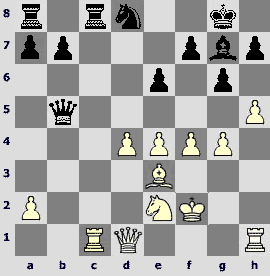
Such a large-scale play is really impressive.
18...¦:c1 19.Ј:c1 ¤c6 20.Јb1. It turns out that pawns march at the queen side was a prelude to the transition to the ending.
20...Ј:b1. Not 20...Јa6 as Black had reasons to be afraid of 21.f5!
21.¦:b1 b6 22.f5! Shirov gains more space. 22.¦c1 ¦c8 led to the cheerless exchange along the open file.
22...¤e7? Too gingerly. Kamsky was afraid to open his king - 22...ef5 23.gf5gf5 24.h6! Ґf6! (24...Ґf8 25.¦c1 ¤e7 26.¦g1 ўh8 27.d5 f6 28.Ґd4 ¤g8 29.e5±, although after 29...¤h6 the situation is not very simple) 25.e5 Ґh4 26.ўf3 І (given by Shirov), and to the natural 22...¦d8 23.e5 Ґf8 comes unpleasant 24.¦с1, and the rook bursts into along «c» line.
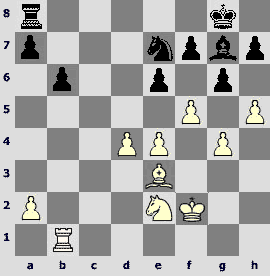
23.h6! Ґf8 24.f:e6. He might have thought about 24.f6 in the previous strategy manner, but White decides to set himself a specific target – e6 pawn.
24...f:e6 25.¤f4 ўf7 (25...e5 26.de5 Ґh6 27. ¤d5 Ґe3 28 ўe3 ¤c6 29.e6 ўg7 30.¦c1 ¦c8 31.g5±) 26.¤h3 ўg8 27.¤f4 ўf7 28.¤h3 ўg8 29.¤g5 e5 30.d5 ¤c8. The capture of the pawn didn't bring relief: 30...Ґh6 31.¤e6 Ґe3 32. ўe3 ¤c8 33.¦c1 ¤d6 34.¦c6,and in spite of having an extra pawn Black's situation is not brilliant, the domination of White is obvious.
31.¦c1 ¤d6 32.¦c7 ¦c8 (32...Ґh6 33.¤h7 ¤e4 34.ўf3 ¤d2 35.Ґd2 Ґd2 36.ўe4 Ґb4 37.¤f6 ўf8 38.ўe5 ¦d8 39.¦a7 with a win – given by Shirov) 33.¦d7 ¦c3
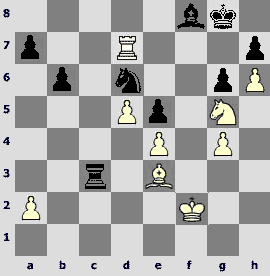
34.¤:h7ќ ¤:e4+ 35.ўe2. one can make a mistake half a way to the triumph : 35.ўf3?? Ґc5.
35...Ґb4 36.¦:a7 b5 37.g5. 37.Ґg5 is also good with the idea ¤f6.
37...¤g3+ 38.ўd1 ¤e4 39.ўe2 ¤g3+ 40.ўd1 ¤e4 41.Ґb6 ¦f3 (41...¦d3 42.ўe2 ¦d5 43.ўe3) 42.Ґd8 ¦f1+ 43.ўc2 ¦f2+ 44.ўb3 Ґc5 45.¤f6+ ¤:f6 46.¦g7+ ўf8 47.g:f6 ¦f3+ 48.ўc2 ¦f2+ 49.ўd1 ¦f1+ 50.ўe2 ¦f2+ 51.ўe1 ¦:a2 52.Ґe7+ Ґ:e7 53.f:e7+ ўe8 54.d6 1–0
Kramnik who is usually so careful has made many weaknesses in the pawn structure on the queen side (pawns can not be moved back!), and Shirov made use of this.
A. Shirov – V. Kramnik C67
Linares 1998
1.e4 e5 2.¤f3 ¤c6 3.Ґb5 ¤f6 4.0–0 ¤:e4 5.d4 Ґe7. Less popular variation of Berlin defense, Smyslov used to like playing it.
6.d:e5. The main line is - 6.Јe2 ¤d6 7.Ґc6 bc6 8.de5 ¤b7І.
6...0–0 7.¦e1. White was trying to gain the advantage by blocking the advance d7-d5 – 7.Јd5 ¤c5 8.Ґe3, but he did not achieve much: 8...a6 9.Ґc5 ab5 10.Ґe7 Јe7 11.¤c3 b4 12.¤b5 ¦a5 13.a4 b6 with the idea Ґа6.
7...d5 8.e:d6 Ґ:d6 9.¤bd2. After 9.Ґс6 bc6 10.Јd4 ¤c5 a pair of bishops offsets the weakening of the pawn structure.
9...Ґf5 10.¤c4 Ґb4 11.c3. Unpromising 11.Ґc6 Ґe1 12.Јd8 Ґf2 13.ўf1 ¦ad8 14.Ґe4 Ґe4 15.ўf2 Ґc2 16.Ґf4 Ґe4=.
11...Ј:d1 12.¦:d1 Ґc5 13.Ґe3 ¤e7
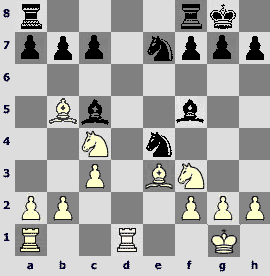
It seems that a peace agreement is forthcoming, but Shirov manages to keep slight pressure.
14.¦e1! Ґ:e3. A first concession – Black allowed his bishop to be exchanged for the knight, and this promises some advantage to White in the open position. 14...¤d5 or 14...¤g6 were also noteworthy.
15.¤:e3 ¤d6 (15...Ґg6 16.¤e5І) 16.¤:f5 ¤e:f5 17.Ґa4!
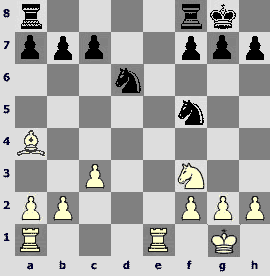
Having a4-e8 diagonal under control and not allowing any simplifications.
17...g6 18.¦e2 b5?! Positional feeling lets Kramnik down and he starts creating weaknesses for himself.
19.Ґc2 ¦fe8 20.¦ae1 ¦:e2 21.¦:e2 a5? He should have confined himself to unpretentious 21...а6.
22.¦e5
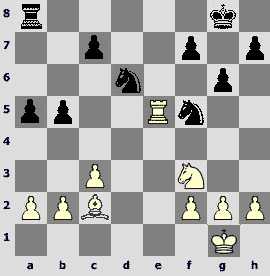
22...b4 23.¦c5. After a few moves the position has changed and the advantage of White became quite noticeable.
23...b:c3 24.¦:c3 ¤b5. The problems can not be solved in a tactical way, passive 24...¦а7 is better.
25.¦c4 ¦d8 26.ўf1 ¤e7?! The task of White becomes easier. More stubborn but hardly helpful 26...¤fd4 27.¤d4 ¦d4 28.¦c5 ¦b4 29.b3 a4 30.ba4 ¤d4 31.Ґd1 ¦b1 32.ўe1.
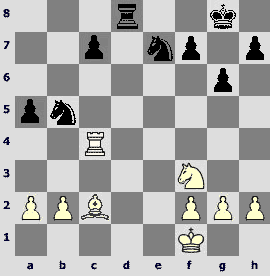
27.a4 ¤d6 28.¦:c7 ¤d5 29.¦c5 ¤b4 30.Ґb3 ¤d3 31.¦:a5 ¤:b2 32.¦d5 ¦b8 33.¤d2. The knight fell into a trap to make things worse.
33...¦b6 34.ўe2 ¦a6 35.¦d4 ¤b7 36.¤e4 ¦b6 37.Ґd5 ўg7 38.ўd2 ¤d6 39.¤c3 ¤f5 40.¦f4 ўf6 41.a5 1–0 (41...¦а6 42.¦b4).
The peak of Alexei's competitive career is his victory in the match against Kramnik in 1998. But the final match (I don't remember according to which version) against Kasparov did not take place in the upshot. There was organized a «consolatory» match against Polgar instead. In this match Judit was pitiful to look at (5,5 : 0,5 in favour of Shirov), although normally they have sore struggles with varying success. «Strong» men sheltered themselves behind the «weak» woman.
A. Shirov – J. Polgar B90
Prague 1999
1.e4 c5 2.¤f3 d6 3.d4 c:d4 4.¤:d4 ¤f6 5.¤c3 a6 6.Ґe3 ¤g4 7.Ґg5 h6 8.Ґh4 g5 9.Ґg3 Ґg7 10.h3 ¤e5. Later Shirov preferred 10...¤f6 as Black.
11.¤f5 Ґ:f5 12.e:f5 ¤bc6 (12...Јa5 13.Јd5 ¤bc6 14.Јa5 ¤a5 15.¤d5 ¦c8 16.0–0–0 with a slight advantage in the complex ending) 13.¤d5 0–0. An interesting attempt 13...е6 14.fe6 fe6 15.¤e3 Јb6!? 16.Јd6 Јb2 17.Јe6 ўf8 18.Јd6 ¤e7 19.¦d1 ¤f7 with unclear consequences.
14.Ґe2 e6 15.f:e6 f:e6 16.¤e3 d5. More solid is 16...Је7 with the idea ¦ad8 and ¤g6,not loosening the pawn structure. But Judit is playing aggressively in her usual style. 17.0–0 Јb6 18.¤g4!
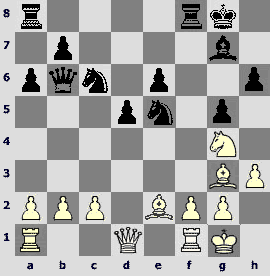
18...¦f5. Judit hesitates to capture the pawn (18...Јb2 19.¦b1 Јa2 20.¦b7 –active rook and a weakened shelter of the black king give a sufficient compensation to White) and focuses the pressure on f2.
19.c3!? Shirov does not want to spend his time on 19.¦b1.
19...Ј:b2. Almost forced. 19...¦af8 20.Јc2 with a more pleasant position for White.
20.¦b1 Ј:c3 21.¦:b7 ¦f7?!
21...¦af8 22.Ґa6 (22.¦c7? ¤g4 23.Ґg4 Јg3! 24.fg3 ¦f1 25.Јf1 Ґd4 26.ўh2¦f1 27.Ґe6 ўf8 28.¦c6 Ґg1 29.ўh1 d4і) 22...¦5f7 with unclear threat (given by Shirov).
22.Јb1 ¦:b7 (22...¦af8? 23.¦f7 ¦f7 24.¦c1 ¦b7 25.Јb7 Јc1 26.ўh2± – given by Shirov) 23.Ј:b7 ¦e8 24.Ј:a6 ¤:g4 25.Ґ:g4 ¤d4 26.¦b1
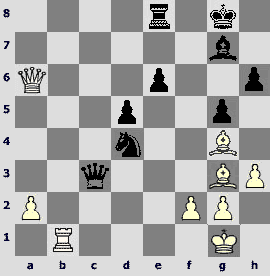
26...Јc2! (26...¤f5 27.Јb5 ¦d8 28.Јb6 ¦e8 29.Ґh5 Ґd4 30.Ґe5! Ґb6 31.Ґc3 ¦b8 32.¦b3І/±) 27.¦b7 Јg6 28.a4 h5 29.Ґd1 h4? In the manner of the previous game of Black was 29...g4 30.hg4 hg4 31.a5 Јe4 and a strong move 32.Јd6 helps to keep the advantage ¦f8 33.Јc7 ¤f5 34.Ґc2 Јd4 35.Ґf4. 30.Ґd6 e5 31.Јa7!
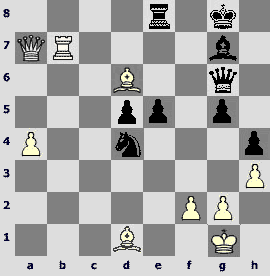
Now it's difficult for Black to organize an effective counterplay, and the game ends quickly.
31...¤f5 32.Ґc5 e4 33.¦b6 ¦e6 34.Ґb3 ¦:b6 35.Ґ:d5+ ўh7 36.Ј:b6 Јh5 37.Јb1 ўh6 38.Ґ:e4 1–0
Alexei has a catastrophic score against two top chess players. He managed to defeat Anand while he didn't manage to score a single goal into Kasparov's net. This fact hampers his achieving of higher competitive successes. The matter can be explained by the fact that both Anand and Kasparov calculate variants deeply and precisely and often prejudice interesting but not always sound (as well as Shirov's great predecessor, a world champion Mikhail Tal who also used to live in Riga) ideas. He often crushes intuitive players (who play basing on general considerations).
Another amusing game for the last bit.
А.Shirov – O. Nikolenko C11
Moscow 1991
1.e4 e6 2.d4 d5 3.¤c3 ¤f6 4.e5 ¤fd7 5.¤ce2. White wants to create a strong center not being confused by the development delay.
5...c5 6.c3 ¤c6 7.f4 b5. More popular is 7...Јb6 8.¤f3 f6 9.a3 Ґe7.
8.a3 a5 9.¤f3 b4 10.a:b4 c:b4 11.f5! e:f5 12.¤f4 ¤b6 13.Ґb5 Ґb7 14.e6! Ґd6 15.e:f7+ ў:f7 16.0–0 ¦e8
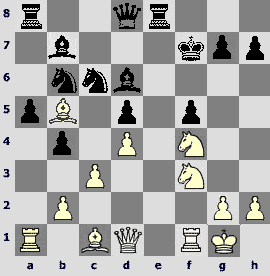
Black has parried the first attacks and has almost accomplished the development.
17.¤:d5! Out of the blue. 17...Ґ:h2+. Hazards of accepting the sacrifice can be illustrated with the following lines:
17...¤d5 18.¤g5 ўg6 (18...ўg8? 19.Јh5; 18...ўf8 19.¦f5 ¤f6 20.Јh5 Јc7 21.Јh7 Ґh2 22.ўf1; 18...ўf6 19.Јh5 g6 20.¤h7 ўe7 21.Ґg5 ўd7 22.Јg6) 19.¦f5!! ўf5 (19...¤e3 20.Ґe3 ¦e3 21.Јb1; 19...Ґh2 20.ўh2 Јc7 21.g3 ¤e3 22.Ґe3 ¦e3 23.¦f4) 20.Ґd3 ўf6 21.Јf3 Ґf4 22.Ґf4 with a decisive advantage in all cases. Only 18...ўе7! gave hope for repelling the attack, but the intensification of the attack can be seen after the scrupulous analysis. Shirov's opponent chooses more practical decision.
18.ў:h2 Ј:d5 19.c4! After 19.¤g5 ўg8 (19...ўg6? 20.¦f5!) 20.Јh5 h6 21.c4 besides 21...¤c4 Black has a response 21...Јd6 22.Ґf4 Јf6. 19.Јd3 was noteworthy with a good compensation for a pawn.
19...¤:c4 20.¤g5+
20...ўg8 21.¦f5! ¤4e5! (dangerous is 21...Јf5? 22.Ґc4 ўf8 23.Јh5! ўe7 24.Ґd2 ¤d4 25.¦f1Јe5 26.Ґf4 with a win) 22.Јh5 (22.de5? ¤d4!) 22...h6 23.de5 hg5 24.b3! ¦e5 (24...Јb3? 25.Јe2!) 25.Ґc4 Јc4 26.¦e5 Јd4 27.¦f5 (27.¦e8=) 27...¤e5 28.¦a5=.
20...ўg6 21.Ґ:c4 (21.¦f5 Јf5 22.Ґc4 ¤d4! 23.Јd4 Јe5) 21...Ј:c4 22.Јf3 ¦f8?
This natural move loses by force. 22...¤e7! 23.Јb7 Јf1 24.Јb6 (24.Јd7?Јa6 25.¦a5 Јc6) 24...ўh5 25.¤e6 Јe1(25...ўg4? 26.¦a3!! ba3 27.Јb3 ўh5 28.¤g7 ўg6 29.Јe6 ўg7 30.Ґh6 ўh8 31.Јf6 ўg8 32.Јg7#!)26.¤g7 ўg4 27.¤e8 Јg3=.
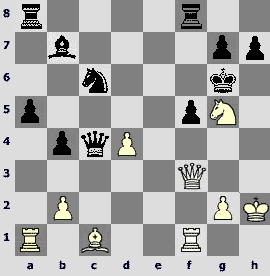
23.Јg3! Ј:f1 24.¤e6+ ўf7 25.d5!
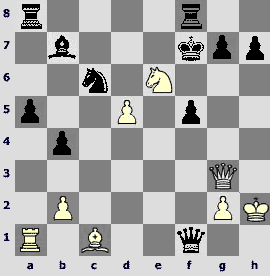
There is no escape!
25...¦g8 26.Јc7+ ўg6 27.d:c6 (27.¤f4) 27...Ґc8?( 27...h6 prolonged the agony) 28.¤f4+ ўf6 29.Јd6+ ўf7 30.Јd5+ ўf8 31.Ґe3! 1–0
